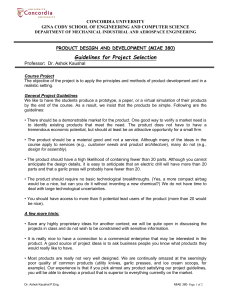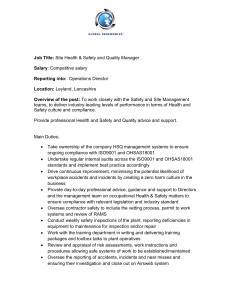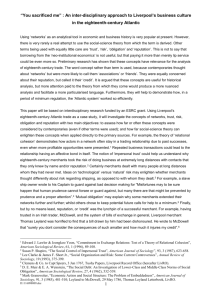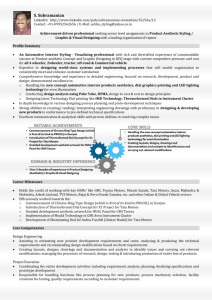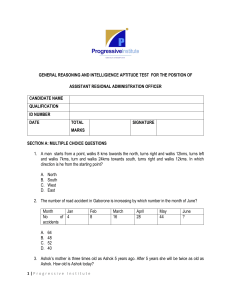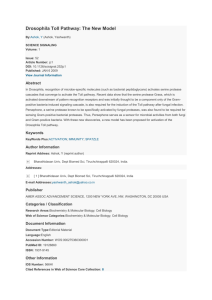Ashok Leyland Training Report: Mechanical Engineering
advertisement
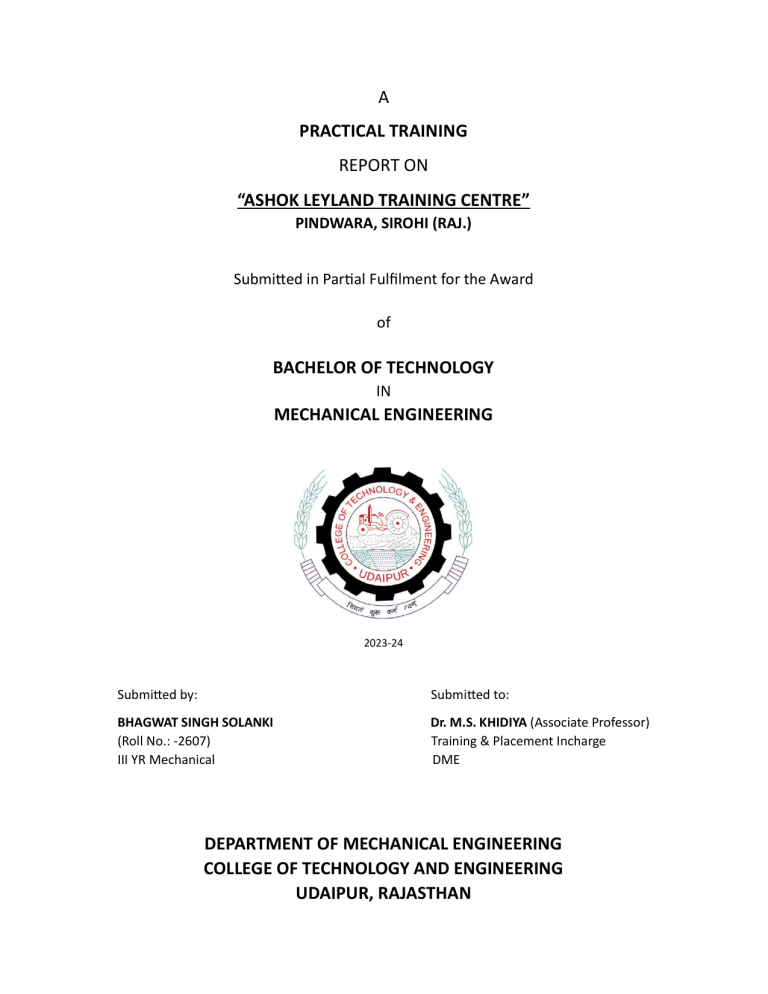
A PRACTICAL TRAINING REPORT ON “ASHOK LEYLAND TRAINING CENTRE” PINDWARA, SIROHI (RAJ.) Submi ed in Par al Fulfilment for the Award of BACHELOR OF TECHNOLOGY IN MECHANICAL ENGINEERING 2023-24 Submi ed by: Submi ed to: BHAGWAT SINGH SOLANKI (Roll No.: -2607) III YR Mechanical Dr. M.S. KHIDIYA (Associate Professor) Training & Placement Incharge DME DEPARTMENT OF MECHANICAL ENGINEERING COLLEGE OF TECHNOLOGY AND ENGINEERING UDAIPUR, RAJASTHAN CERTIFICATE ACKNOWLEDGEMENT: I wish to record my sincere thanks to the RAJESH MOTORS (AUTO) PVT.LTD for giving permission to undergo training for thirty days (30 days) in the organiza on. I was given a proper knowledge about the Leyland trucks(mainly) at the site was kept me on the site for observing each ac vity accomplish over there. I take opportunity to thank Mr. Gajendra Singh Chouhan (Works manager) for se ng a mission with a complete vision. I have pleased to thank lab technicians, supervisor and workers for the organiza on for their whole-hearted help as well as coordina on as I have gained the knowledge about the work culture. CONTENTS 1. VISION AND MISSION........................................................................... 5 2. HISTORY ............................................................................................... 5 3. PARTNERSHIP ....................................................................................... 6 4. TYPES OF VEHICLE PRODUCED BY ASHOK LEYLAND .............................. 8 5. TECHNOLOGY ..................................................................................... 13 6. TYPES OF SERVICE PROVIDED BY ASHOK LEYLANDError! Bookmark not defined. 7. SERVICE CENTER ................................................................................. 17 8. REGULAR MAINTAINCE....................................................................... 18 9. RE-PAINTING ...................................................................................... 23 10. WARRENTY CLAIM OF A VEHICLE...................................................... 24 11. SERVICING OF REPAIR VEHICLE ......................................................... 25 12. 3116 ................................................................................................. 25 13. CONCLUSION .................................................................................... 27 1. VISION AND MISSION 1.1 VISION ● Leadership in Medium and Heavy Segment ● Significance Presence in Market World ● Customer Sa sfac on 1.2 MISSION ● Large Produc on ● Moderniza on ● Global Benchmarking our Product, Process & People ● Good Rela onship Management 2. HISTORY Ashok Leyland is an Indian automobile company headquartered in Chennai, India. It is owned by the Hinduja Group. Founded in 1948, it is the second largest commercial vehicle manufacturer in India, fourth largest manufacturer of buses in the world and 10th largest manufacturer of trucks globally. Opera ng nine plants, Ashok Leyland also makes spare parts and engines for industrial and marine applica ons. It sold approximately 140,000 vehicles (M&HCV + LCV) in FY 2016. It is the second largest commercial vehicle company in India in the medium and heavy commercial vehicle (M&HCV) segment, with a market share of 32.1% (FY 2016). With passenger transporta on op ons ranging from 10 seaters to 74 seaters (M&HCV = LCV), Ashok Leyland is a market leader in the bus segment. In the trucks segment Ashok Leyland primarily concentrates on the 16 to 25-ton range. However, Ashok Leyland has a presence in the en re truck range, from 7.5 to 49 tons. 2.1 Ashok Motors Ashok Motors was founded in 1948 by Raghunandan Saran. He was an Indian freedom fighter from Punjab. A er Independence, he was persuaded by India's first Prime Minister Nehru to invest in a modern industrial venture. Ashok Motors was incorporated in 1948 as a company to assemble and manufacture Aus n cars from England, and the company was named a er the founder's only son, Ashok Saran. The company had its headquarters in Rajaji Saalai, Chennai (then Madras) with the plant in Ennore, a small fishing hamlet in the North of Chennai. The company was engaged in the assembly and distribu on of Aus n A40 passenger cars in India. Under Leyland Raghunandan Saran had previously nego ated with Leyland Motors of England for assembly of commercial vehicles as he envisioned commercial vehicle were more in need at that me than were passenger cars. The company later under Madras State Government and other shareholders finalized for an investment and technology partner, and thus Leyland Motors joined in 1954 with equity par cipa on, changing the name of the company to Ashok Leyland. Ashok Leyland then started manufacturing commercial vehicles. Under Leyland's management with Bri sh expatriate and Indian execu ves the company grew in strength to become one of India's foremost commercial vehicle manufacturers. The collabora on ended some me in 1975 but the holding of Bri sh Leyland, now a major Bri sh Auto Conglomerate as a result of several mergers, agreed to assist in technology, which con nued un l the 1980s. A er 1975, changes in management structures saw the company launch various vehicles in the Indian market, with many of these models con nuing to this day with numerous upgrades over the years. 3. PARTNERSHIP In 1987, the overseas holding by Land Rover Leyland Interna onal Holdings Limited (LRLIH) was taken over by a joint venture between the Hinduja Group, the Non-Resident Indian transna onal group and Iveco, part of the Fiat Group. 3.1 Hinduja Group In 2007, the Hinduja Group also bought out Iveco's indirect stake in Ashok Leyland. The promoter shareholding now stands at 51%. Today the company is the flagship of the Hinduja Group, a Bri sh-based and Indian originated transna onal conglomerate. 3.2 Hino Motors During the early 1980s Ashok Leyland entered into a collabora on with Japanese company Hino Motors from whom technology for the H-series engines was sourced. Many indigenous versions of the H-series engine were developed with 4 and 6 cylinders, and also conforming to BS2, BS3 & BS4 emission standards in India. These engines proved to be extremely popular with the customers primarily for their excellent fuel efficiency. Most current models of Ashok Leyland come with H-series engines. Japan entered into a Mutual Coopera on Agreement (MCA) on 27 November 2017 renewing their coopera ve agreement that had started in 1986. According to the agreement Ashok Leyland will use Hino's engine technology for its Euro 6 development and will support in the development of Hino's engine parts purchasing in India for global opera on. 3.3 Rosoboronexport & ELCOM Ashok Leyland Defence Systems (ALDS), Russia's Rosoboronexport and ELCOM Group have signed a coopera on agreement in defence business to provide tracked vehicles to Indian Armed Forces. The agreement was signed on the side lines of the Interna onal Military Technical Forum Army – 2017 held at Kubinka, near Moscow, on 25 August 2017. 3.4 IIT Madras Ashok Leyland and Indian Ins tute of Technology Madras (IIT Madras) signed a memorandum of understanding, on 19 August 2017, for Ashok Leyland to sponsor the Centre of Ba ery Engineering (CoBE) at IIT Madras. As part of the agreement Ashok Leyland has partnered with IIT Madras to carry out research and development (R&D) ac vi es for strengthening ba ery engineering and related sub-parts, especially for electric vehicles. 3.5 Sun Mobility On 18 July 2017 Ashok Leyland announced the forma on of an alliance with SUN Mobility, the global partnership aims to develop electric vehicles. 3.6 Iveco partnership In the late 1980s Iveco investment and partnership resulted in Ashok Leyland launching the 'Cargo' range of trucks based on European Ford Cargo trucks. The Cargo entered produc on in 1994, at Ashok Leyland's new plant in Hosur, southeast of Bengaluru. These vehicles used Iveco engines and for the first me had factory fi ed cabs. Though the Cargo trucks are no longer in produc on and the use of Iveco engine was discon nued, the cab con nues to be used on the Eco met range of trucks as well as for several of Ashok Leyland's military vehicles. The Cargo was originally introduced in 7 and 9 long tons (7,100 and 9,100 kg) versions; later, heavier-duty models from 15 to 26 long tons (15,200 to 26,400 kg) were progressively introduced. 4. TYPES OF VEHICLES PRODUCED BY ASHOK LEYLAND a) Heavy commercial vehicle ● Haulage trucks ● Low floor Buses and heavy commercial bus ● Tractor-trailer/semi-trailer ● Tipper b) Light commercial vehicle ● Delivery vans ● Mini trucks ● Ambulance ● Staff or school vans c) MPV STILE d) DEFENSE VEHICLE ● GSUPER STALLION 10x10 ● GURU 4x4 – 715 ● PPC 4X4 4.1 Buses Current range • MTC • 12M • 12M FESLF • Viking • Cheetah • Eagle • Electric Bus • Freedom • Hawk • Hybus • JanBus • Lynx • Mitr Ashok Leyland MiTR (or MiTR) is a Minibus manufactured by Ashok Leyland in Joint venture with Nissan. The vehicle was unveiled in January 2014 during the 12th Auto Expo 2014 and was launched in July 2014. • Oyster • 12M RE • RESLF • REULE • Sunshine • Titan In 1968, produc on of the Leyland Titan ceased in Britain, but was restarted by Ashok Leyland in India. The Titan PD3 chassis was modified, and a five-speed heavy duty constant-mesh gearbox was used together with the Ashok Leyland version of the O.680 engine. The Ashok Leyland Titan was very successful and con nued in produc on for many years. 4.2 Former range • Comet Early products included the Leyland Comet bus which was a passenger body built on a truck chassis sold in large numbers to many operators in India. By 1963, the Comet was operated by every state transport undertaking in India, and over 8,000 were in service. It was soon joined in produc on by a version of the Leyland Tiger. • Panther • Falcon 4.3 TRUCKS 4.4.1 Haulage truck Haulage truck is the most common form of materials transport in open pit mines. The trend has been towards larger and larger open pit trucks to match larger shovels and excavators. It is used to carry a payload of more than 6ton to 40 ton It is used in transport of Market load, construc on and parcel. 4.4.2 TRACTOR-TRAILER A large propor on of a semi-trailer's weight is supported by a tractor unit, or a detachable front-axle assembly known as a dolly, or the tail of another trailer. A semi-trailer is normally equipped with landing gear (legs which can be lowered) to support it when it is uncoupled. It is a combina on of tractor and a trailer connected by fi h wheel coupling It is used for transpor ng heavy duty construc on machinery. The tractor usually has tandem axles at the rear, which provide a fuel saving of 4% It also protects the tyre from the wear 4.4.3 TIPPER ● The pper is used for transpor ng dumps such as gravel, sand or demoli on waste, which is to be deposited on ground ● A typical pper is equipped with an open-box bed, which is hinged at the rear ● It contains hydraulic rams to li the open box at front through which the dumps can be deposited behind the truck 4.5 Trucks Current range • 1618 • 2518 • 3118T 8x4 • Captain 5525 (High demand in market) • • Ecomet • U-Truck Ashok Leyland announced the sale of vehicles on the new U-Truck pla orm in November 2010 with the rolling out of the first set of 10 models of ppers and tractor trailers in the 16 to 49-tonne segment. Another 15 models were set to enter the market in the following 12 months. • Boss Boss is an intermediate commercial vehicle launched by Ashok Leyland. It is available in the range of 8T to 14T. It is available with two engine op ons 120 IL (LE) and 130 CRS (LX) engines, and this is the first me such an engine has been offered in this range of trucks. The LX variant is available with air condi oning and Leyma c AMT, which are again industry firsts. Former range • Beaver • Rhino 4.6 Light Vehicles Current range • Dost The Dost is a 1.25-ton light commercial vehicle (LCV) that is the first product to be launched by the Indian-Japanese commercial vehicle joint venture Ashok Leyland Nissan Vehicles. Dost is powered by a 58 hp high-torque, 3-cylinder, turbo-charged common rail diesel engine and has a payload capacity of 1.25 tonnes. It is available in both BS3 and BS4 versions. The bodywork and some of the underpinnings relate to Nissan's C22 Vane e of the 1980s; this is most visible in the door design. The LCV is produced in Ashok Leyland's Hosur plant in Tamil Nadu. The LCV is available in three versions. With the launch of Dost Ashok Leyland has now entered the Light Commercial Vehicle segment in India • Guru • Partner 4.7 Ashok Leyland Defence Systems Vehicle Factory Jabalpur (VFJ)'s Stallion 4X4 Truck for the Indian Army An Indian road-mobile launcher with a ballis c missile Ashok Leyland's Stallion Kavach 4X4 Mine Protec on Armoured Vehicle Ashok Leyland Defence Systems (ALDS) is a newly floated 5. Technology Ashok Leyland railbus manufactured by Sri Lanka Railway engineers It was the first in India to introduce mul -axled trucks, full air brakes and innova ons like the rear engine and ar culated buses. In 1997, the company launched the country's first CNG bus, and in 2002 developed the first hybrid electric vehicle. A Rural Mobile health clinic built on Ashok Leyland's e-comet truck Ashok Leyland was already producing low-emission vehicles. Back in the 1980s and 1990s, Ashok Leyland with various Tamil Nadu Transport Corpora on, notably Cholan Roadways Corpora on based in Tiruchirappalli, experimented with low pollutant emission based on the CNG technology. In 2002 it developed the first hybrid electric vehicle. Ashok Leyland has also launched a mobile emission clinic that operates on highways and at entry points to New Delhi. The clinic checks vehicles for emission levels, recommends remedies and offers ps on maintenance and care.Hythane engines Ashok Leyland has also developed hythane engines in associa on with the Australian company Eden Energy. Ashok Leyland successfully developed a 6cylinder, 6-litre (370 cu in) 92 kW (123 hp) BS-4 engine which uses hythane (HCNG,) which is a blend of natural gas and around 20% of hydrogen. Hydrogen helps improve the efficiency of the engine but the CNG aspect makes sure that emissions are at a controlled level. A 4-cylinder 4-litre (240 cu in) 63 kW (84 hp) engine is also being developed for H-CNG blend in a joint R&D program with MNRE (Ministry of New and Renewable Energy) and Indian Oil Corpora on. 5.1 Euro 6 Truck AT the Delhi Auto Expo 2016, the company showcased its first indigenously produced Euro 6 truck 4940. The truck is powered by the company's flagship range of engine, Neptune, which is an 8l engine that produces 400 hp and 1600Nm of torque. The truck is designed to meet Euro 6 norms.[37] 5.2 IEGR In 2017, the company showcased IEGR (intelligent exhaust gas recircula on) technology for its trucks and buses to meet BS-IV emission standards. The technology also promises other advantages like be er fuel efficiency than BS-III trucks, and power transmission up to 400 HP. 6. SALES AT RAJESH MOTORS Rajesh motors Auto Pvt Ltd are not par cularly in sales segment but they have their good contact in trucks field in Sirohi belt and they have regular customer NTC(na onal transport company) so they just take orders for limited firms Image of delivering of vehicle (captain 5525) to firm ‘person 7. TYPES OF SERVICE PROVIDED BY ASHOK LEYLAND ● QUICK SERVICE ● ONSITE SERVICE ● SERVICE STATION 7.1 QUICK SERVICE It is an innova ve service offering that customises doorstep service and ensures faster up me, par cularly at project/remote sites. It offers best-in-class servicing infrastructure in a mobile unit. The Quick Service vehicle is equipped with worksta ons, tools, lubricants and spare parts to handle any possible service requirement and mobile wheel alignment equipment. Each unit is manned by two or three trained mechanics. 7.1.1 Periodic Maintenance Services: With a sharp focus on vehicle upkeep for uninterrupted running, Ashok Leyland’s pre-emp ve maintenance is an integral part of Quick Service. 7.1.2 Break Down Assistance: It leverages the best of Ashok Leyland’s technology and its vast network to track, trace and rush to assistance to increase up me. 7.2 ONSITE SERVICE It is a 20-foot or 40-foot workshop in a container, fully equipped to provide service to medium and heavy commercial vehicles. Each workshop comes with the service capacity of one bay and two trained mechanics. Engine scanning can be set up with minimal support infrastructure and at very short lead me. It ensures uninterrupted up me, be er profits and more economy for customers, through some key features. 7.2.1 Perfect at Project Sites: Onsite Service can act as a hub for maintenance in loca ons where vehicles are deployed for a fixed period. These are ideal for project sites locked in for a specific period, but with significant servicing requirements. 7.2.2 Deep Access: It is an invaluable ini a ve in remote sites/hill sites, where available space is a constraint. SLR SERVICE CENTER 8. SERVICE CENTER ● Outstanding service marke ng abili es. ● Capability to invest Rs.25-30 Lakhs on service infrastructure conforming to Ashok Leyland Standards. ● Site area of 12000 sq for a 4 bay facility. ● Strong commitment to building long term rela onships with customers. ● Ambi on to grow the service business. SLR BAY 8. REGULAR MAINTAINCE ● coolant top-up ● air & oil filter replacement ● engine oil service ● diesel filer replacement ● differen al oil service ● hub greasing ● adjus ng drive belts, ming belts, hoses and brake pads ● monitoring res ● monitoring suspension systems ● inspec on of headlight, tail light, indicators and reverse light ● For a smooth maintenance service must be done every 8000km. ● service is done based on kilometers and hours Gear box trolly 8.1 BASED ON KILOMETERS The vehicles that are used for carrying load are serviced based On kilometers. Examples: Trailers and Tarus 8.2 BASED ON HOURS The vehicles that are used for sta onary opera on are serviced Based on hours Examples: Bore vehicles, ppers Trucks are rugged and reliable machines designed to operate in tough condi ons. That doesn’t mean, however, that they don’t’ need maintenance. Regular maintenance of your truck fleet is cri cally important to ensure good performance, safe opera on and longevity of your fleet. Scheduled servicing can detect and rec fy minor problems before they become bigger issues that affect produc vity. It is self-evident that merely replacing a few light bulbs from me to me will not prolong a truck’s life. 8.3 COOLANT OIL TOPUP Coolant oil top up is necessary because it reduce the heat of an engine, top it up using a 50/50 mixture of water and an freeze (for normal driving condi ons), or pour pre-mixed an freeze straight into the reservoir. You can use clean tap water in an emergency, but an freeze should be added as soon as possible. 8.4 Replacing lubricants (engine & differen al oil) Oil is used for lubrica on of internal combus on engines. The main func on of motor oil is to reduce fric on and wear on moving parts and to clean the engine from sludge (one of the func ons of dispersants) and varnish (detergents). Lubrica ng the crown assembly 8.5 Inspec ng the brakes Checking to see if the brakes are working properly is a crucial part of basic truck maintenance and definitely something you should do at the start of every working day. In addi on to daily checks, it is vital to regularly have a good mechanic subject your brake shoes, air dryers and air valves to a check-up to determine if all parts are in working order. 8.6 Replacing all filters A truck cannot operate at full capacity with a dirty transmission filter, oil filter, fuel filter, air filter or exhaust filter. Also remember to check if the cabin air filter needs replacing. 8.7 Checking of clutch oil Check the clarity of the oil. If the oil looks like it contains debris or looks cloudy, it definitely needs to be changed. 8.8 Check the electrical system Are all fuses s ll in working order? Any light bulbs that need replacing? 8.9 Check all rubber parts Rubber wears out and becomes hard and bri le with replacement of all hoses and res is crucial. me, so mely 8.9.1 Check all gaskets Gaskets should be replaced immediately if worn or leaking, or whenever removed during servicing. Replacing gaskets is a simple task, but you may have to dismantle the engine in order to reach them. When in doubt, always contact a technician. 8.9.2 Check the shock absorbers Shock absorbers are essen al for a smooth and even ride. If your truck doesn’t se le rela vely quickly a er you’ve driven over a pothole, it’s probably me to treat your truck to a new set of shock absorbers. 9. RE-PAINTING 10.1 STEPS INVOLVED IN REPAINTING STEP 1 Remove all of the door handles, trim, emblems and chrome from the truck. Wash the truck then dry well. STEP 2 Sand the exis ng paint down on the truck. Pay close a en on to any areas with paint Chips, making sure they are sanded well to blend into the rest of the truck. Apply primer and allow to dry completely. STEP 3 Use a so rubber block to wet-sand over the dried primer. Make sure it is sanded enough that you can see a shine on the truck from any side angle. Apply dent filler to any dents in the body of the truck. STEP 4 Use a 16-inch file board to sand the filler on all flat panels on the truck. Use a 36grit file strip to sand down any larger dents that have a heavier applica on of filler. Con nue applying more filler and sanding it down un l all surfaces are equally smooth. STEP 5 Apply a coat of epoxy primer to the sanded truck. STEP 6 Use a leaf blower to blow off any remaining dust or debris. Wash the truck with water. Dry well with a large cloth. STEP 7 Clean the work area in the garage well, removing all traces of dirt and dust from the surrounding walls and the floor. STEP 8 Rremoving any traces of grease or oil on the truck. Apply masking tape to the truck windows, wheels and any other parts that you do not wish to paint. STEP 9 Use the paint gun to begin applying paint to the truck. Paint in a horizontal direc on, from front to back and then again from back to front. Paint slowly but steadily to avoid paint drips. Use a ladder to paint the roof. Lie on the floor and spray upwards to paint under the door. Allow the paint to dry and then apply a second and third coat. Use a commercial grade automo ve buffer to buff the truck a er the paint has dried, to produce a clean, shiny finish 11. WARRANTY CLAIM OF A VEHICLE 11.1 CONDITIONS FOR WARRANTY CLAIM 1) The period of warranty on major aggregates - Engine, Gear Box, Front Axle and Rear Axle, shall be 36 months from the date of sale or 3,00,000 kms, whichever is earlier. 2) The warranty extended to the first registered owner of the vehicle only. In the event of transfer or any aliena on the warranty shall be terminated 3) In the event of any defect being discovered within the period the vehicle should be brought to the nearest AL Dealer workshop, to avoid consequen al damages. Incidental expenses, towing charges have to be borne by the customer. 4) The obliga on under warranty shall be limited to either repairing or replacing free of charge such parts of the major aggregates as are deemed to be defec ve in the opinion of AL and shall not extend to replacement of assemblies and consequen al losses. The replaced part shall become property of AL. 5) The customer will be responsible for ● The cost of non-durable materials (lubricants, fuel, grease, filters etc.,), rubber items, paint coa ngs etc. ● The cost of maintenance and lubrica on opera ons ● The cost of repairs made necessary by normal wear and tear, accidents or improper use not authorized by AL or by improper storage or negligence ● The cost of on-road repairs, towing, parking and insurance ● The cost of repairs caused by damage due to fire, flood, earthquake or such natural calami es or by civil disturbances 12. SERVICING OF REPAIR VEHICLE 12.1 MALFUNCTION OF CLUTCH A tractor had a clutch malfunc on. Even when the clutch pedal is pressed the clutch was in engaged condi on. Due to this issue there was poor accelera on, difficulty in gear shi ing. The reason is due to the damaged piston in the master cylinder. Then the master cylinder is replaced. 12.2 PROPELLER SHAFT UNIVERSAL JOINT A truck with two live rear axle has one universal joint broken due to overload. The torque transmi ed was very high the universal joint could not hold that high torque so it broke. Then the universal joint is replaced 13. 3116 ● 31 denotes maximum ton that can be carried by the vehicle ● 16 denotes horsepower of the engine A 12 wheeled vehicle has 2 front axle, two rear axle front axle can carry a load of 6.5 ton rear axle can carry a load of 9 ton 6.5 x 2 = 13 9 x 2 = 18 Total = 31 ton 16 should be considered as 160. THEREFORE, THE VEHICLE HAS 160 HORSEPOWER Inspec ng the ECU of the trucks for the errors and warranty claim Genera on of failure report a er the inspec on process 14. CONCLUSION During our training period we no ced that the technicians are working with all safety equipment like shoes, mask, gloves, and apron. We were inspired by seeing this work culture and all the employees were performing their work in order. The engines which are claimed through warranty are le to rust in the open space at the backside of the service centre. So, a separate shed should be built to prevent the engine from rus ng. The vehicles which are damaged due to accidents are le in many places of the service centre, there are glass, sharp metal pieces around. It may injure the technicians. So, it should be sent to scrap as soon as possible. The vehicles which are completed service had been let to stay for many hours since the bill was not cleared. So, a separate staff has to be allo ed for billing sec on.
